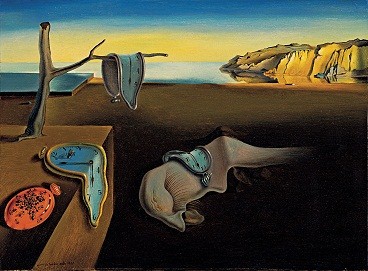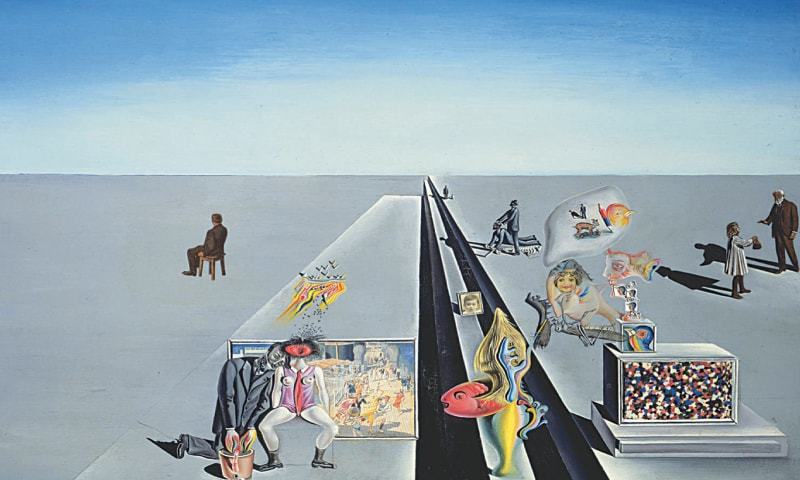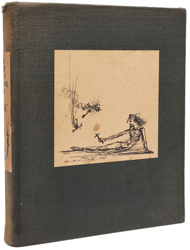Stephanie Jellison - Selected Works of Salvador
Dali

The Persistence of Memory, 1931
Museum of Modern Art, New York
 1939
1939 |
Salvador Dali was born on May 11, 1904 to a
wealthy family in the agricultural town of Figueres, Spain.
His parents built his first studio at their summer home in the
coastal fishing village of Cadaques. In 1925, Dali held his
first one-man show in Barcelona. Three of his paintings were
shown in the Carnegie International Exhibition in Pittsburgh
in 1928, and he held his first one-man show in Paris in 1929.
Around this time, Dali joined the surrealists and met Gala Eluard,
the wife of poet Paul Eluard. Gala became Dali's lover and chief
inspiration, and the two were eventually married. During his
surrealist period, Dali painted The Persistence of Memory,
which remains today as one of the most well-known surrealist
works. As World War II approached in 1934, Dali clashed with
the surrealists primarily because he was apolitical and was
"expelled" from the group. Dali's thoughts on the
matter are summed up as follows: "The difference between
me and the surrealists is that I am Surrealism" (Museum
Website). In 1940, Dali stopped exhibiting his art
in international surrealist exhibitions and began working with
a new style that is now called his "classic" period.
Dali's works from this period focus on religion and science.
Dali and his wife Gala escaped from Europe during World War
II and lived in the United States from 1940 to 1948. During
this time, Dali had his first major retrospective exhibit at
New York's Museum of Modern Art and also published his autobiography
titled The Secret Life of Salvador Dali. After the war,
Dali and Gala moved back to Spain and made their home in Port
Lligat. In 1974, Dali opened the Teatro Museo in his hometown
of Figueres. Gala passed away in 1982, and Dali's health began
to deteriorate. He spent most of the rest of his life in seclusion
and died on January 23, 1989 from heart failure with respiratory
complications.
|
Dali is considered to be an great artist with brilliant
creativity. His works embody a wide array of styles and media and
prove Dali to be a very talented and well-rounded artist. Collections
of Dali's art include everything from drawings and watercolors to
jewels and sculptures. The transitions of his work from his early
impressionist period through his surrealist era to his classical works
show that Dali was constantly evolving and maturing as an artist.
Several years after his death, Dali continues to be a famous artist
whose works set a standard for modern art.
 The First Days of Spring, 1929
The First Days of Spring, 1929, Salvador Dalí
Museum, St. Petersburg, Florida
|
The works of Sigmund Freud served as one of
Dali's main influences. As a movement, surrealism focused on
dreams and the imagination rather than the rational mind and
based many of its ideas on Freud's works on the unconscious.
In addition to this fascination with fantasy, Dali was also
very interested in Freud's ideas about the competitive father/son
relationship and the Oedipus scenario. Two works that demonstrate
this Freudian influence particularly well are The First Days
of Spring (1929) and Meditation on the Harp (1932-1934).
Dali called his surrealist paintings "hand-painted dream
photographs," but The First Days of Spring seems
to be more of a nightmare than a dream. This work is the product
of a mind full of turmoil, for Dali's personal life was troubled
at this time. His relationship with his father was rapidly deteriorating,
and he was suffering from mental anxiety in the form of violent
fits of uncontrollable laughter. Dali was saved from his own
madness by Gala, who helped him focus his anxiety into paranoid
visions that became some of his most famous works of art. The
First Days of Spring contains much symbolism that represents
Dali's worsening relationship with his father. The Salvador
Dali Museum website describes some of that symbolism as follows:
"A small photograph of Dali as a child is pasted in
the center of the barren landscape, and the two tiny figures
standing in the background represent Dali's longing for the
time when he and his father were close." In addition
to this father-son symbolism, there are many other interesting
images that seem to represent an extreme fantasy. One of the
most striking is the object at the bottom of the painting that
appears to be part fish, part thermometer, and part hair. These
bizarre illustrations and the intensity of the colors used combine
to give this painting a very eerie, nightmarish feeling.
|
Dali's Meditation on the Harp combines the
influence of Freud with another of the artist's major inspirations.
Jean-Francois Millet's 1857 painting entitled The Angelus
appeared in a dream of Dali's in 1932. It seemed to have a powerful
effect on the artist, and perverse manipulations of this work
are evident in many of Dali's own pieces. In fact, Dali was so
obsessed with Millet's painting that he wrote his own interpretation
of it entitled The Tragic Myth of Millet's Angelus. In
this interpretation, Dali argued against the traditional suggestion
that the famous painting is about the reverence of evening prayer.
Instead, Dali found the painting to be symbolic of sexual repression
and male sexual anxiety. He envisioned the female peasant as a
femme fatale character and suggests that the male peasant's hat
is hiding an erection from her. Dali explained that the male peasant
would have to cover up his arousal because the female peasant
would mate with him and then cannibalize him as if she were a
praying mantis. Furthermore, Dali felt that there was something
"present but unseen" in The Angelus (Museum
website). He believed that this suspicion was proven to be accurate
when the curators of the Louvre Museum x-rayed Millet's painting
in 1963 and found a small box at the peasants' feet. Dali interpreted
this hidden box as a casket containing the couple's dead son and
said that Millet followed a friend's advice to paint over it.
From this radical interpretation, Dali created Meditation on
the Harp and many other works dealing with the Angelus theme. |
 Meditation On The Harp, 1932-1934
Salvador Dalí Museum, St. Petersburg,
Florida
Meditation On The Harp, 1932-1934
Salvador Dalí Museum, St. Petersburg,
Florida |
In Meditation on the Harp, the peasants are giants that dominate
the landscape, and the female character is naked to symbolize her
"carnal intentions" (Museum website).
The death-like character in the front of the painting symbolizes the
couple's resurrected son, who "intervenes in the relationship
between his father and mother and embodies the death that is the inevitable
male fate" (Ades and Bradley 20).
In keeping with the Freudian influence, the son is portrayed with
a very large, bone-like foot to represent Oedipus, whose name is literally
translated as "swollen foot." The female character seems
to have one hand on the male peasant and the other on the son, which
may symbolize the father-son competition that Freud discusses. Furthermore,
the son is pictured in tattered black clothing, which helps to suggest
infanticide. Like The First Days of Spring and many of Dali's
other paintings, Meditation on the Harp contains characters
that seem very unrealistic and dream-like. This work is overflowing
with symbolism and is a perfect illustration of two of Dali's main
influences: Jean-Francois Millet's The Angelus and Sigmund
Freud's works on both the unconscious and the Oedipus scenario.

The Angelus by Jean-François Millet, 1857 - 1859
Musée d'Orsay, Paris
Bibliography:
Dali, Salvador. The First Days of Spring. www.salvadordalimuseum.org/cgi-bin/SoftCart.exe/collection/surreal/spring.html?L+dali+ymqg7043+1039550659
Dali, Salvador. Meditation on a Harp. www.salvadordalimuseum.org/cgi-bin/SoftCart.exe/collection/surreal/harp.html?L+dali+ymqg7043+1039545744
Ades, Dawn and Fiona Bradley. Salvador Dali: A Mythology.
Tate Gallery Publishing, London: 1998.
Millet, Jean-Francois. The Angelus. www.arts-lettres-et-techniques.tm.fr/anglais/millet1.htm
Salvador Dali Museum Website. St. Petersburg, Florida. www.salvadordalimuseum.org
Secrest, Meryle. Salvador Dali. E. P. Dutton, New York: 1986.
Ades, Dawn. Dali. Thames and Hudson, London: 1995.

The Secret Life of
Salvador Dali, 1942 ed.
|